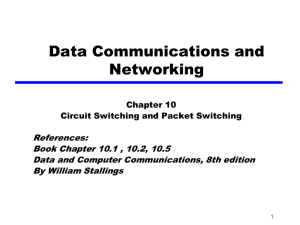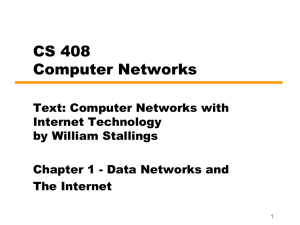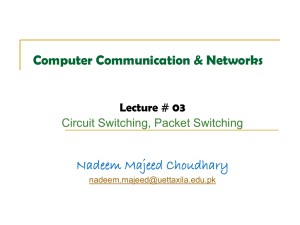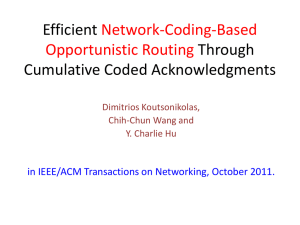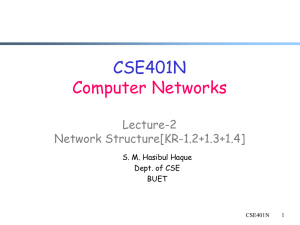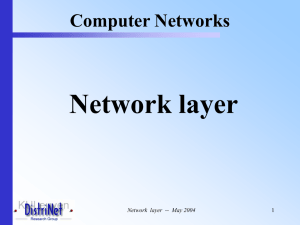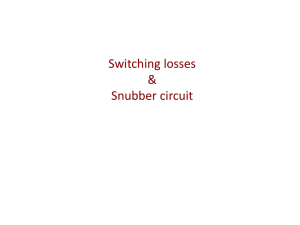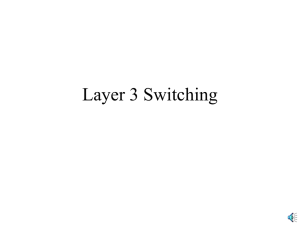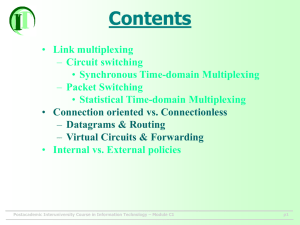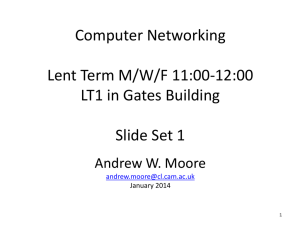Ch01
advertisement
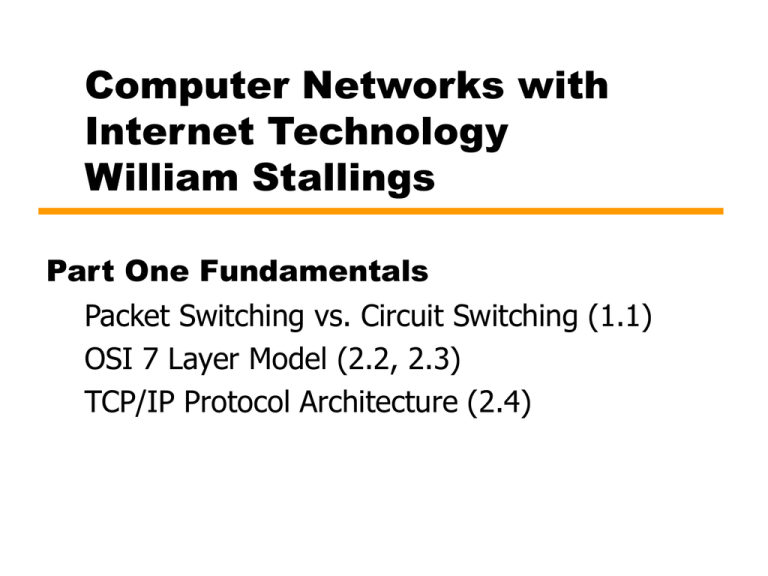
Computer Networks with Internet Technology William Stallings Part One Fundamentals Packet Switching vs. Circuit Switching (1.1) OSI 7 Layer Model (2.2, 2.3) TCP/IP Protocol Architecture (2.4) A Simple Switching Network Node Station 1.1 Data Networks • Communication by transmitting data through a network of intermediate switching nodes • Switching nodes not concerned with content • End devices referred to as stations —Computers, terminals, telephones, etc. • Nodes connected by transmission links (trunks), in some topology. • Station attaches to node (by access links) • Collection of nodes is a communications network Switching • Fully Connected vs. Switching Network • What does “switching” mean? — Switching Circuits/Fabric — Switching Behavior • Switch — Switching Hub — Layer-2 Switch — Layer-3, 4 Switch • Switch vs. Router Circuit Switching • Dedicated path between two stations —Connected sequence of links between nodes —E.g telephone network • Communication involves three phases —Circuit establishment —Data transfer —Circuit disconnect Circuit Establishment • • • • Station A to node 4 requesting connection to station E Circuit from A to 4 usually dedicated line Node 4 finds next leg to node 6 Based on routing information, availability, cost, node 4 selects circuit to node 5 • Allocates a free channel Circuit: — TDM [time-division multiplexing] Channel / Link — FDM [frequency-division multiplexing] • Node 4 requests connection to E • And so on Multiplexing Data Transfer • Data may be digital (e.g., terminal to host) or analog (e.g., voice) • Signaling and transmission may each be digital or analog • Path is A-4 circuit, internal switching through 4, 4-5 channel, internal switching through 5, 5-6 channel, internal switching through 6, 6-E circuit • Generally, full duplex (data in both directions) Data , Signaling, Transmission Circuit Disconnect • Connection terminated —Usually by one of the stations • Signals to 4, 5, and 6 to de-allocate resources Circuit Switching - Notes • • • • Connection established before data transmission begins Channel capacity must be available and reserved. Nodes must have capacity to handle connection Switches must have intelligence to make allocations and devise route • Can be inefficient — Capacity dedicated for duration of connection • Even if no data are being transferred — For voice, utilization high, but still doesn’t approach 100% — For terminal connection, may be idle most of the time — Delay prior to data transfer for call establishment — Once circuit established, network transparent to users — Data transmitted at fixed rate • No delay other than propagation • Delay at node negligible Packet Switching – Circuit Switching Issues • Designed for voice • Resources dedicated to particular call • For voice, high utilization —Most of the time, someone is talking • For data —Line idle much of the time —Constant data rate • Limits interconnection of variety of host computers and terminals Packet Switching – Basic Operation • Data are transmitted in short blocks, called packets, typical upper bound 1000 octets (bytes) • Longer messages broken up into series of packets • Transmitting computer sends message as sequence of packets. • Packet includes control information including destination station. • Packets sent to node to which sending station attaches • Node stores packet briefly, determines next leg of route, and queues packet to go out on that link • When link is available, packet is transmitted to next node • All packets eventually work their way through network Figure 1.2 The Use of Packets Packet Switching – Advantages • Line efficiency greater — Node-to-node link dynamically shared by many packets • Data-rate conversion — Each station connects to its node at its proper data rate — Nodes act as buffers • Packets accepted, even under heavy traffic, but delivery delay increases — Circuit switching networks would block new connections • Priorities can be used Packet Switching – Disadvantages • Delay — Transmission delay equal to length of packet divided by incoming channel rate — Variable delay due to processing and queuing • Packets may vary in length, take different routes, … — May be subject to varying delays — Overall packet delay can vary substantially (jitter) — Not good for real-time applications like voice and real-time video • Overheads including address of destination, sequencing information added to packet — Reduces capacity available for user data • More processing required at node Switching Techniques • Datagram — Each packet is treated independently. • Virtual Circuit — Sending packets via a preplanned route, similar to circuit switching. Switching Technique - Datagram • Datagram: each packet treated independently — No reference to packets that have gone before — Each node chooses next node on path — Packets with same destination address do not follow same route — May arrive out of sequence — Exit node or destination restores packets to original order — Packet may be destroyed in transit — Either exit node or destination detects loss and recovers • Call setup avoided • For an exchange of a few packets, datagram quicker • More flexible. — E.g. Routing away from the congestion — Delivery is inherently more reliable • If a node fails, subsequent packets may be re-routed Figure 1.3 Packet Switching: Datagram Approach Switching Technique – Virtual Circuit • Preplanned route established before packets sent • All packets follow same route • Similar to circuit in circuit-switching network — Hence virtual circuit • Each packet has virtual circuit identifier — Nodes on route know where to direct packets — No routing decisions • Not dedicated path, as in circuit switching — Packet still buffered at node and queued for output — Routing decision made once for that virtual circuit • Network may provide services related to virtual circuit — Sequencing and error control • Packets should transit more rapidly • If node fails, all virtual circuits through node lost Figure 1.4 Packet Switching: Virtual-Circuit Approach Effect of Packet Size on Transmission Time Routing • Adaptive routing —Routing decisions change as conditions on network change — Failure of node or trunk — Congestion • Route around congestion • Requires exchange of network state information —Tradeoff between quality of information and overhead Discussion • Data comm. Vs. Voice comm. • What if the Internet is circuit-switching? • What if the telephone network is packetswitching? • The failure of WAP • The success of Skype?

